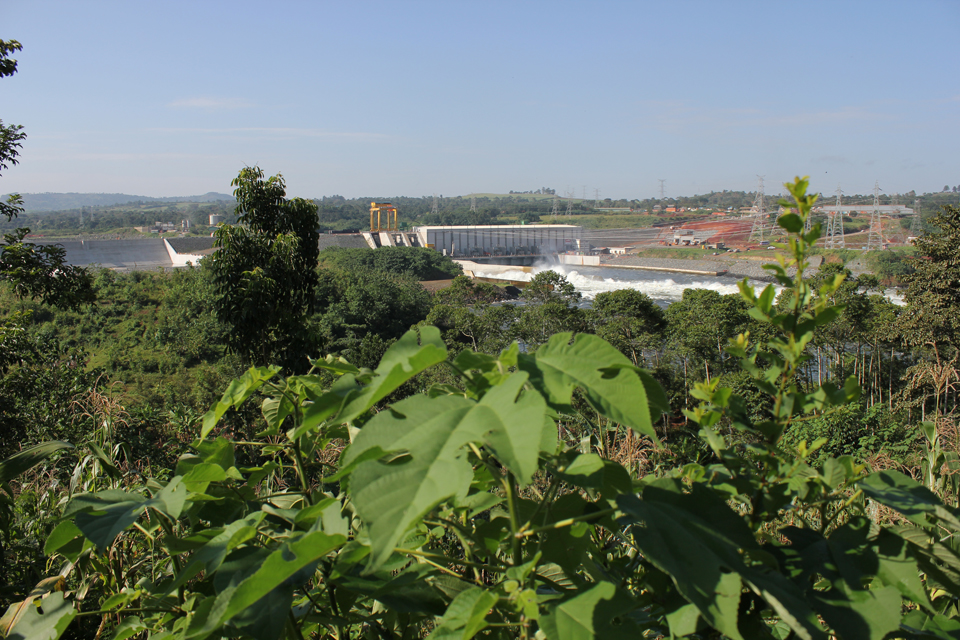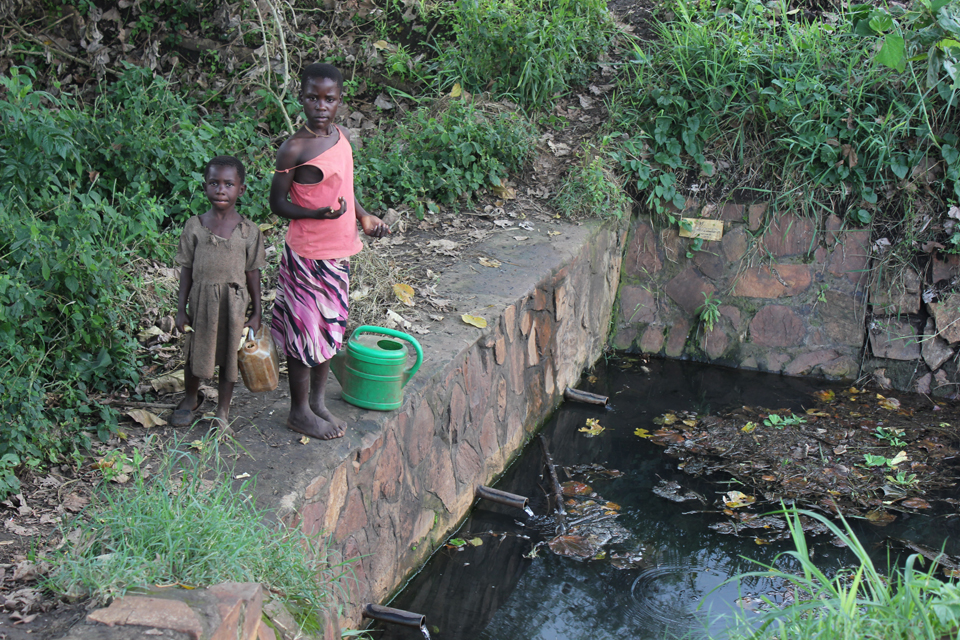
The Bujagali dam in Uganda was finalized in 2012, photo: Anette Tjomsland
Swizeen Ndyabawe
The construction of the 250 MW Bujagali hydropower dam in Eastern Uganda was funded by The International Finance Corporation (IFC), a private sector lending arm of the World Bank, alongside other development banks. It was developed by The Aga Khan Fund for Economic Development (AKFED). The process for the construction of the dam started in the late 1990s and was inaugurated in October 2012 by the President of Uganda.

Swizeen Ndyabawe is a grad student at the Center for human rights at the University of Oslo and is currently interning at the Fivas office, photo: Jonas Holmqvist
Approximately 8,700 people (about 1,288 households) were affected by the construction of the dam either indirectly or directly. The people who previously stayed around the Bujagali area were promised by the government of Uganda and the dam developers that the dam would come with benefits.
There were promises of provision of jobs to the population, affordable electricity, clean running water, schools for the children, modern health centres and good roads running through their community. These benefits were used to convince the locals to accept the project.
Corruption Allegations
Corruption allegations hovered around the Bujagali power project, though after investigations no one has been convicted.
On August 20 2002, A Ugandan newspaper (New Vision) reported that the Ugandan president had quizzed the former Minister of Energy over a bribe he was accused of receiving to influence the bidding process. It is alleged that the minister had received a bribe from Veidekke International AS which had been contracted by a United States of America affiliated company AES Nile power to build the dam. An earlier attempt by AES to construct the dam was partly hindered by allegations of corruption. These corruption allegations coupled with delays in crucial approvals by parliament of Uganda led to the failure of the project to take off for almost 10 years from the time of its inception.
For future projects to produce the intended benefits, efforts should be made to reduce the time between planning and implementation stages by ensuring transparency and corruption free process.
Compensation of the local people
The ground breaking for the project took place in 2002 and construction started. However this resulted into long-term hardship and impoverishment of the affected communities. The failure to resolve all legal issues prior to the commencement of project activities created uncertainty especially for those people who were involuntarily resettled.
These people had a right to be compensated for the loss of their property. However, up to now some still have unresolved resettlement and compensation issues. This calls for an independent party to monitor the resettlement and a different a mechanism where grievances can be handled at local level if similar future projects are to be implemented in the future. This will help the affected individuals to easily file their grievances and answers without going through the court process which has proved slow and expensive for the local people

Children from one of the villages that were forcefully moved because of the Bujagali dam. The village was given fish farming dams to compensate their losses by the organization Souluganda and the developer Bel. When Fivas visited the village in 2011 the fishermen told us that they now had to use half a year to earn 70 000 Ugandan shilling, something they used to only spend a week doing previously, photo: Anette Tjomsland
The shortage of systematically collected data about the situation of the project affected people
before the commencement of the projects makes it difficult to establish if the resettlement plan met all the requirements of the applicable human rights instruments protecting the rights of the people who previously settled in Bujagali.
Lost access to resources and livelihood
The project permanently submerged highly productive agricultural land as well as islands holding valuable natural habitats. The changes to the river permanently harmed fisheries. This is because the area around the Bujagali Falls supported a substantial number of subsistence and commercial fishermen, who depended on the resource for both food and income. The affected people were moved to a new area called Naminya and they were promised to be fully compensated.
However, compensation for the people moved to the Naminya resettlement site resulted into different concerns. These include the quality of the houses received, lack of land title for the land given as compensation, and unfulfilled promises to provide the community with a primary school, community centre, health centre, a road connecting the community to the main road, and a market and other employment and income generating opportunities.
Project affected people should be meaningfully consulted and should have the opportunity to participate in planning and implementing resettlement programs. But in the case of Bujagali though, the project affected people were only informed about the project, they were not adequately educated about their human rights and their right to a consultation process and free, prior and informed consent. This is not sufficient according to international law.
People affected by the project were not involved in the planning or implementation of the resettlement plan, but were rather informed about the choices available once the plan was already in place. They were not given an opportunity to contribute to the drafting of the resettlement plans, but were rather only informed of the two available options. This is a strong indicator of a lack of informed and meaningful consultations from the local communities to be affected by the project, thus the majority were forced to relocate to make way for the construction of the dam against their will.
Social services
Right to education and access to basic medical care. In Bujagali, the families had schools very near their homes, close enough for the children, children had easy access to school facilities and other social services like health centers where medical services were easily accessible. The government and dam developers promised all the project affected people that in the resettlement village all these services would be readily available before relocation and would be located near their homes. However the nearest Universal Primary school was about 3-4 miles from the village and many missed out on educational opportunities which violated their right to education which should be fulfilled by the state. Health centers were also not readily available to the people in the new place which affected their right to access basic medical care. Therefore in future government and contractors should make sure that the social services are first availed in the resettlement areas before relocation so that peoples rights area not violated .
Informed consent of the affected people
The project affected people were not consulted in the process of pricing their property, but were instead forced to accept what the dam developer and the government had determined that they deserved. This was done by the government appraisers who were in charge of valuation of the affected people’s property without informing the affected people about what rates were going to be used during the valuation process and were not given copies of the valuation reports and survey forms, this violated their right to be compensated by the government during compulsory acquisition of property which is enshrined in Article 26 (2) (b)(i) of the 1995 constitution of Republic of Uganda. It provides that there should be prompt payment of fair and adequate compensation, prior to compulsory acquisition of land by government for public use.
Project-affected people who had to be physically relocated from the construction site were given a choice between two types of compensation packages: a full resettlement package or a cash compensation package. The people who chose cash compensation were required themselves be responsible for finding alternative places to reside, while the ones who chose the full resettlement package were relocated to the Naminya resettlement village in 2001 where the services promised were not readily available. This resulted in a lot of suffering, especially for the vulnerable members of the community like the elderly and children.
The Ugandan law requires that displaced persons are provided with support after displacement for a transition period based on a reasonable estimate of time likely to be needed to restore their livelihood and standards of living.
This includes development assistance such as land preparation costs which was not fulfilled. Therefore future plans should cater for livelihood sustainability issues, compensating families for the assets and crops lost is not enough as was in the case of Naminya. The quality of the soil in the new place should have also been considered.
Compensation should be done by central government and the contractor in partnership with local governments in the affected areas in order to increase ownership of the process by the local community, consideration of the community interests and sustainability of the project benefits. This is also because private contractors by law are not accountable to the local community, but the government and the funders of the project are. Thus in case of compensation issues, the government can be held accountable by the people.

